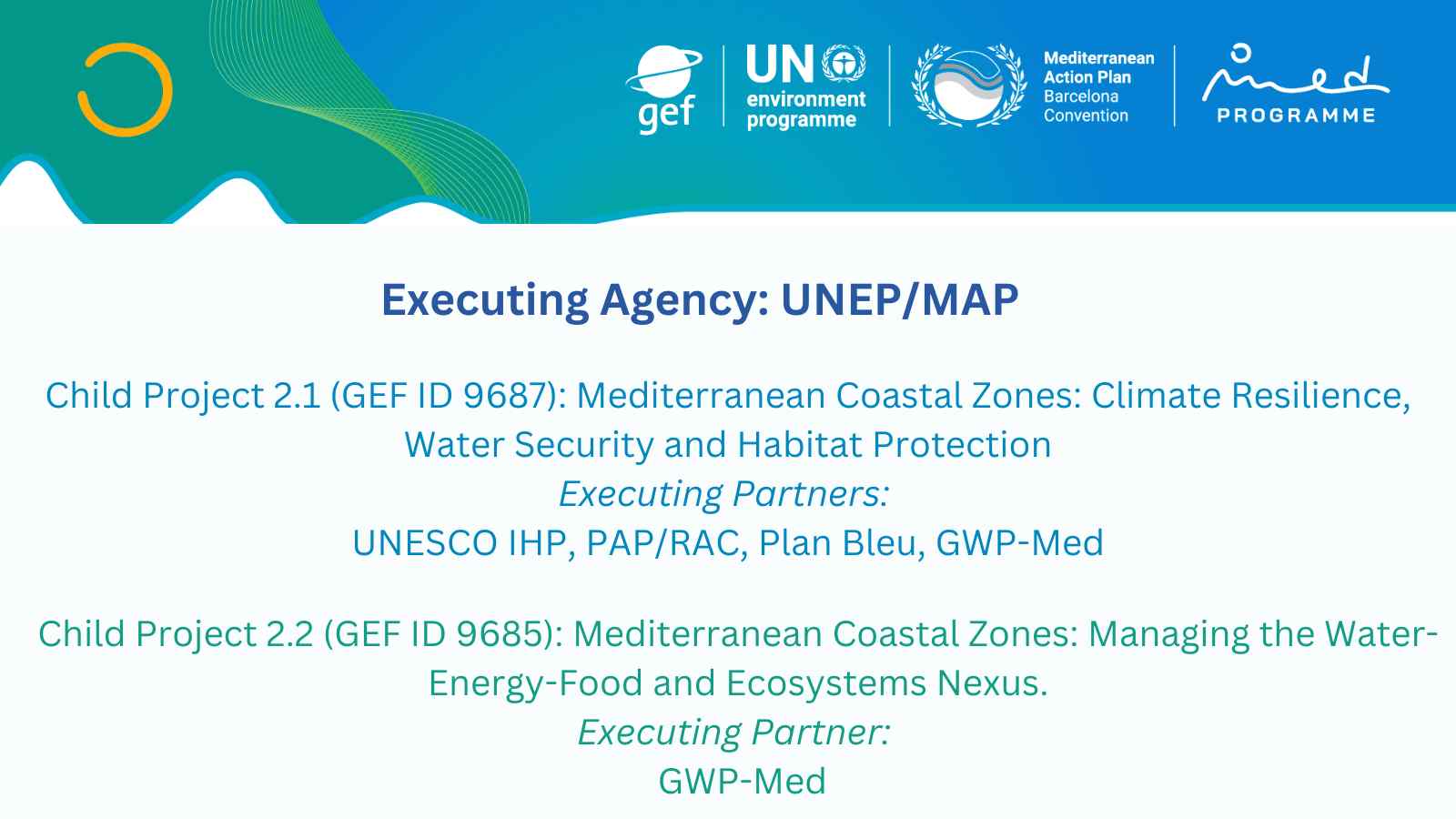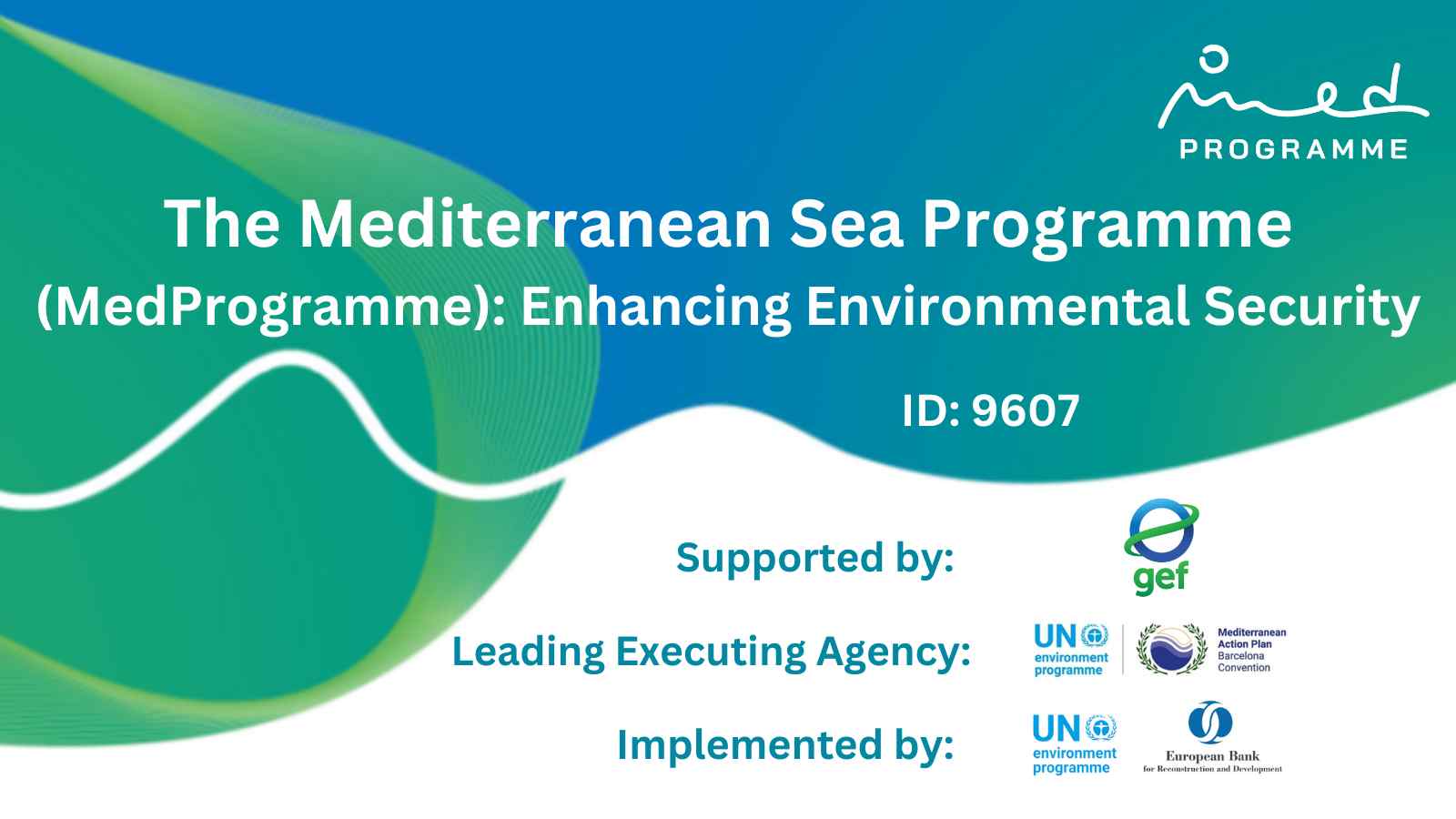The GEF UNEP/MAP “Mediterranean Sea Programme: Enhancing Environmental Security” (2019-2024) represents the first GEF programmatic multi focal area initiative in the Mediterranean. It brings together 9 beneficiary countries Albania, Algeria, Bosnia and Herzegovina, Egypt, Lebanon, Libya, Montenegro, Morocco, Tunisia and 12 Partners namely: UNEP/MAP, UNEP, EBRD, UNESCO IHP, EIB, Plan Bleu/RAC, PAP/RAC, SCP/RAC, SPA/RAC, IUCN Med, WWF Med, GWP-Med.[1]
Its ultimate aim is to operationalize actions to reduce major transboundary environmental stresses in Mediterranean coastal areas, strengthen climate resilience and water security and ultimately improve the health and livelihoods of coastal populations in a a sustainable, gender responsive and equitable way.
It is a joint effort that builds on a number of projects implemented in the Mediterranean basin that have provided information on the state of the Mediterranean environment in light of climate change as well as the findings of the Transboundary Diagnostic Analysis (TDA) for the Mediterranean*.
The MedProgramme, a pioneering initiative: Innovation, Sustainability and Scaling Up
The innovative, multi-programmatic approach of this initiative is a response to the recognition that, in many, if not most cases, the priority responses to environmental degradation require integrated interventions across multiple areas (e.g water, chemicals and waste pollution, biodiversity degradation etc.) due to the complexity of its drivers.
For the MedProgramme, overall security can be achieved by creating intelligent synergies and fair trade-offs among the water, food, energy and environment sectors, while providing opportunities for innovation and learning to minimize security risks and enhance resource efficiency and equity. It moreover recognises that all parameters that affect the coast and the marine ecosystems should be seen as a “continuum”, from the Source to the Sea, including human activities that take place inland.
The Programme is meant to achieve multiple benefits at the National, Regional and Global levels, by supporting regional and global soft and binding international environmental agreements, and enhancing the capacity of the countries to implement them and mainstream them into policy making.
These include MEAS - Multilateral Environmental Agreements- for e.g. the Barcelona Convention and its Protocols such as the ICZM, Convention on Biological Diversity, Basel Convention, United Nations Convention to Combat Desertification, Rotterdam Convention, Stockholm Convention, the 2030 Sustainable Development Goals with focus on Goals 6, 13 and 15 and the Agenda 2030 process and other instruments and programmes, among them the Stockholm and Minamata Conventions and the UN Environment Global Programme of Action.
Reflecting the priorities adopted by the Contracting Parties to the Barcelona Convention while also aiming to deliver a set of complementary results embracing three categories of priorities as these were identified by the TDA, it is articulated around three components or main objectives, namely:

These objectives are achieved through the implementation of more than 100 coordinated action under eight “Child Projects” that cut across four different Focal Areas of the Global Environment Facility (International Waters [IW], Biodiversity [BD], Chemicals and Waste [CW], and Climate Change [CC]) and involve a wide spectrum of developmental and societal sectors, ranging from governmental and non-governmental bodies, the private sector, industry, research, media, various organizations and banking institutions. The European Bank for Reconstruction and Development (EBRD) and the European Investment Bank (EIB) will provide a cash co-financing of USD 700 million in the form of loans granted to the countries and to public/private actors to foster market creation and transformation and ensuring sustainability through the private sector and municipal involvement.
|
MedProgramme |
||
|
MedProgramme Component |
Child Project |
GEF Focal Areas |
|
|
1.1 “Reducing from Harmful Chemicals and Wastes in Mediterranean Hotspots and Measuring Progress to Impacts” |
International Waters (IW), Chemicals and Waste (CW) |
|
1.2 “Mediterranean Pollution Hot Spots Investment Project” |
International Waters (IW), Chemicals and Waste (CW) |
|
|
1.3 “Mediterranean Sea Finance for Water Systems and Clean Coasts” |
International Waters (IW), Chemicals and Waste (CW) |
|
|
2.Enhancing Sustainability and Climate Resilience in the Coastal Zone |
2.1 “Mediterranean Coastal Zones Climate Resilience Water Security and Habitat Protection” |
International Waters (IW) |
|
2.2 “Mediterranean Coastal Zones: Managing the Water-Food-Energy-Ecosystems NEXUS” |
International Waters (IW) |
|
|
SCCF “Enhancing Regional Climate Change adaptation in the Mediterranean Marine and Coastal Areas” |
Climate Change (CC) |
|
|
3.Protecting Marine Biodiversity |
3.1 “Management Support and Expansion of Marine Protected Areas in Libya” |
Biodiversity (BD) |
|
4. Knowledge Management and Programme Coordination |
4.1 “Mediterranean Sea Basin Environment and Climate Regional Support Project” |
International Waters (IW), Chemicals and Waste (CW) |
Med Programme Components, Child Project and GEF Focal Areas
Working in synergy for long lasting beneficial impacts in coastal zone management approaches in the Mediterranean region
The MedProgramme, particularly through two of its sub-projects (Child Projects 2.1 and 2.2), aims to assist Med countries in understanding better and exploring the potential benefits of the Nexus approach in a Source-to-Sea continuum, through relevant activities carried out at the National, sub-National and Regional levels.

Child Project 2.1 with the title “Mediterranean Coastal Zones: Water Security, Climate Resilience and Habitat Protection” aims at improving water security, human and ecosystem health, and climate resilience in coastal hot spots. Its objectives are the strengthening and expansion of Integrated Coastal Zone Management in the Mediterranean region and the improvement of sustainability of the services provided by coastal aquifers and by groundwater-related coastal habitats. The Project is structured around two Components:
- Coastal Zone Management (whereby activities at the national and regional level are executed by PAP/RAC, Plan Bleu/RAC and GWP-Med) integrating also climate adaptation approaches (through the SCCF Project)
- Management of Coastal Aquifers and Related Ecosystems (whereby activities at the national and regional level are executed by UNESCO IHP)
GWP-Med is contributing to the preparation of the Integrated Coastal Zone Management (ICZM) Strategy for Lebanon and the ICZM Plan-Schema Regional du Littoral for the Moroccan Region of Tanger-Tetouan-Al Hoceïma (TTA) - activities led by PAP/RAC - through its efforts to integrate the results of the Water-Energy-Food-Ecosystem (WEFE) Nexus approach in the above processes and resulting documents.
While operating in synergy with Child Project 2.1, Child Project 2.2 “Mediterranean Coastal Zones: Managing the Water-Energy-Food and Ecosystems Nexus" aims at balancing competing water uses in priority coastal areas through water, food, energy and ecosystems integrated governance, to enhance environmental security and sharing of benefits.
Under Child Project 2.2 a set of activities are being implemented structured around four Components, executed by Global Water Partnership-Mediterranean (GWP-Med) aiming at:
- Understanding the interlinkages among the Nexus sectors and related issues;
- Identifying solutions in response to challenges for fostering water-food-energy security, reduction of land based nutrient pollution and other pressures, protection of coastal habitats and biodiversity and climate change resilience;
- Supporting the development of Nexus Strategies and/or Action Plans as parts of existing or in-the-making plans and strategies e.g. ICZM plans and strategies;
- Seeking for and test novel approaches for addressing management issues and work to upscale these;
- Developing project proposals enabling priority solutions/interventions to address pressing issues identified.
These synergies between the two Projects (Child Project 2.1 and Child Project 2.2) are expected to facilitate - and actually strengthen - the efforts of the countries’ stakeholders to enhance the protection of their coastal environment and natural resources security by implementing integrated strategies and approaches and promoting sustainable development.
For related activities, see links below:
[1] GEF Lead Implementing Agency: UN Environment. Other GEF Implementing Agency: European Bank for Reconstruction and Development (EBRD). Leading Executing Agency: UN Environment/MAP. Executing partners: UNESCO International Hydrological Programme (IHP), European Investment Bank (EIB), Global Water Partnership – Mediterranean (GWP-Med), WWF Mediterranean Programme Office (WWF MedPO), IUCN, Priority Actions Programme Regional Activity Centre (PAP/RAC), Plan Bleu Regional Activity Centre (Plan Bleu), Specially Protected Areas Regional Activity Centre (SPA/RAC) and the Sustainable Consumption and Production Regional Activity Centre (SCP/RAC)
SCCF: Special Climate Change Fund “Enhancing regional climate change adaptation in the Mediterranean Marine and Coastal Areas”.
*TDA: Transboundary Diagnostic Analysis
